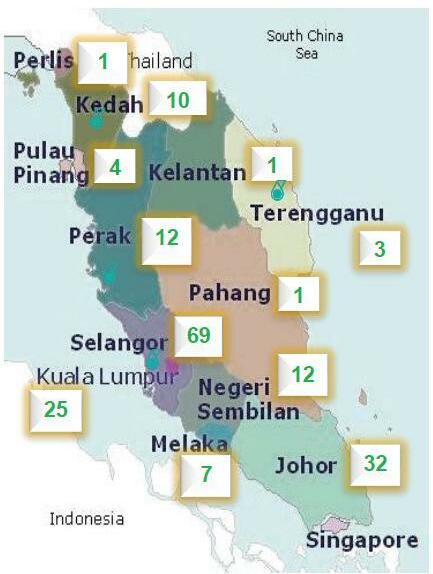
3 minute read
Figure 52: Number of NGV Stations by States
Figure 52: Number of NGV Stations by States
Source: Malaysiangas. com
Off-site hydrogen production using SMR of natural gas is a possible option in Malaysia because natural gas already has wide gas utilisation networks in the Peninsular and smaller distribution network in Sarawak as shown in Figure 51. The most likely location of off-site SMR plants would be at petrol service stations that are already equipped for natural gas refuelling of natural gas vehicles (NGV). However, the number of existing petrol stations with NGV refuelling stations 61 is too few at less than 200 (177), Most of them are located in the Klang Valley, and only 5 stations are available on the east coast of Peninsular Malaysia (Figure 53). 61
3.4.4 Carbon Capture and Storage (CCS)
Since SMR of natural gas also produces carbon dioxide as a by-product, the latter must be removed by CCS that reduces carbon emission by storing it in suitable underground geologic formations. Although CCS technology could reduce atmospheric carbon emissions up to 85%, it adds additional costs to hydrogen production (Board on Energy and Environmental Systems 2014).
Deploying CCS also incurs large incremental investments especially for grass roots CCS projects depending on the type of capture technology and fossil fuel used, location of the geologic storage, and percentage of captured carbon dioxide. The high capital and operating costs are due to the additional carbon capture equipment, while the additional amount of electricity required by the capture equipment can decrease the net power output of the plant considerably.
Data from the National Energy Technology Laboratory (NETL) in 2010 shows that the cost of CCS for levelized cost of electricity (LCOE) of a newly built natural gas combined cycle (NGCC) power plant with CCS is about 46% more than without CCS. The US estimate on the cost of industrial carbon capture and transportation for hydrogen plants is in the range of USD36.67-46.12 per metric tonnes, while the Environmental Protection Agency gives an estimate of USD15 per metric tonne for the long-term average cost of carbon transportation and storage.
There are currently 14 large-scale CCS projects in operation around the world, with 8 still under construction, which represents a total carbon capture capacity of around 40 million tonnes per year. Various CCS projects are under development in several countries with a total carbon capture capacity of around 64 million tonnes per year. Although CCS is still a relatively expensive technology, captured carbon dioxide can potentially bring in revenue from its use in enhanced oil recovery (CO2-EOR) projects. The CO2-EOR offsets the high costs and lessen the financial risks for early adopters of CCS projects (Global CCS Institute 2015). Malaysia already has one of the largest CO2-EOR projects in Southeast Asia in the Tapis field led by ExxonMobil in partnership with Petronas.
62 62
3.4.5 Recovery of hydrogen from hydrogen off-gases in oil refineries and petrochemical plants
Large quantities of hydrogen off gases are flared off from oil refineries and olefin plants in Port Dickson, Melaka, Kerteh, Tanjung Pelepas, and Pengerang. Hydrogen could be extracted from these off-gases quite easily instead of being burnt off. Hydrogen in oil refineries is produced from natural gas by large SMR plants and is used to improve the quality of the fuel. Unreacted hydrogen offgases are flared off as refinery off-gases (ROG). Straight chain naphtha is cracked by a fluidised catalytic cracker (FCC) into branched, cyclic and aromatic components to improve the RON of petrol. Typical FCC contribution for the hydrogen component in ROG is 10-50 mol% (Malik & Slack, 2009).
Hydrogen could be extracted from refinery and petrochemical off-gases using a pressure swing adsorber (PSA) to get hydrogen purity of 99.9% or higher. Impurities in the off-gases, such as sulfur and arsenic, could be removed by the adsorption method using high capacity sorbents as they can poison the catalysts used in the conversion. Low steam to carbon ratio design (typically 2.5 mol H2O/C-atom or lower) for a hydrogen plant can result in a smaller equipment size, which reduces the capital cost, and in a more energy-efficient plant, lowers the operating costs (Rostrup-Nielsen & Rostrup-Nielsen, 2001).







